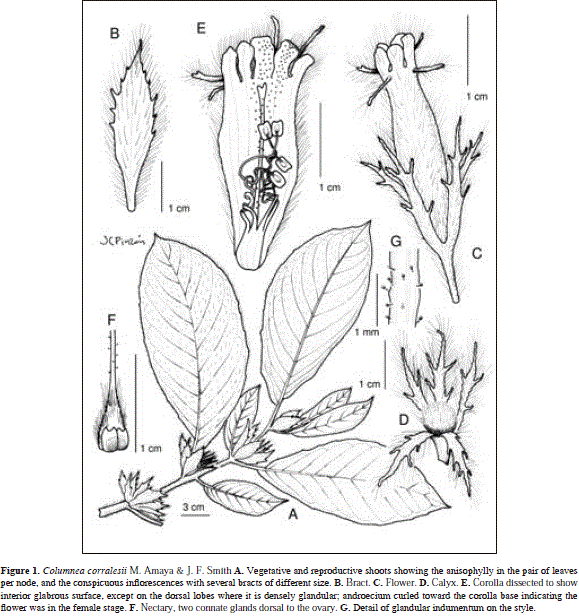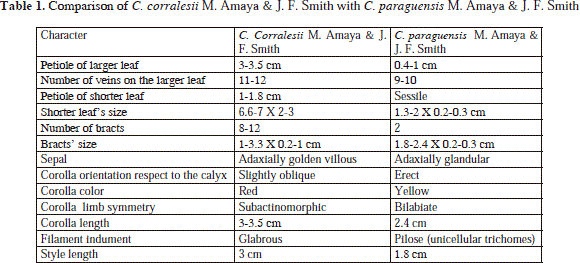Servicios Personalizados
Revista
Articulo
Indicadores
-
 Citado por SciELO
Citado por SciELO -
 Accesos
Accesos
Links relacionados
-
 Citado por Google
Citado por Google -
 Similares en
SciELO
Similares en
SciELO -
 Similares en Google
Similares en Google
Compartir
Revista de la Academia Colombiana de Ciencias Exactas, Físicas y Naturales
versión impresa ISSN 0370-3908
Rev. acad. colomb. cienc. exact. fis. nat. vol.37 no.144 Bogotá jul./set. 2013
CIENCIAS NATURALES
** Department of Biological Sciences, Boise State University 1910 University Drive, Boise ID 83725, U.S.A. jfsmith@boisestate.edu
ABSTRACT
A new species of Columnea belonging to section Ortholoma (Gesneriaceae) from Antioquia Department in Colombia (Cordillera Occidental) is described and illustrated. This species is the second one known in Columnea to have a corolla with 4 external appendages; the first one described with this trait was C. paraguensis. This trait adds to the knowledge on the diversity of corolla architecture in Columnea, and points out an effect of pollinators on the diversification process in this plant lineage.
Key words: Ortholoma, Columnea, Gesneriaceae, Colombia, Antioquia, Plant Taxonomy, Flora of Colombia.
RESUMEN
Se describe e ilustra una nueva especie de Columnea perteneciente a la sección Ortholoma (Gesneriaceae) para el departamento de Antioquia en Colombia (Cordillera Occidental). Esta especie es la segunda conocida dentro de Columnea por tener una corola con 4 apéndices externos; la primera descrita con esta característicafue C. paraguensis. Esta característicaaumenta el conocimiento sobre la diversidad en la arquitectura de la corola en Columnea, e indica un efecto de los polinizadores en el proceso de diversificación de este linaje de plantas.
Palabras clave: Ortholoma, Columnea, Gesneriaceae, Colombia, Antioquia, Taxonomía de Plantas, Flora de Colombia.
Introduction
Studies on the taxonomy of Columnea have shown several changes during the past few years. The phylogenetic classification resulting from molecular data indicates changes at sectional classification (Smith et al. 2013a.). In addition, several new species of Columnea have been discovered either as the result of new expeditions to South America to collect Gesneriaceae (Clark & Smith 2011, Amaya-Márquez & Clark 2011; Amaya-Márquez & Smith 2012; Amaya-Márquez & Marín-Gómez 2012; Smith et al. 2013b) or as the result of revising thousands of herbarium specimens during the last seven years by J. F. Smith for the treatment of section Ortholoma and M. Amaya-Márquez, L. E. Skog, and L. P. Kvist for the treatment of section Collandra (Amaya-Márquez 2010a, 2010b). Columnea corralesii, the new species reported in this paper, was discovered as a specimen in herbaria that did not match any previously described species. This species belongs to the group of species within section Ortholoma that have external appendages on the corolla; we assign this species to section Ortholoma until a new name for this group of species is available.
Columnea corralesii M. Amaya & J. F. Smith, sp. nov. Figure 1.

TYPE: COLOMBIA. Antioquia: municipio de Frontino, corregimiento de Nutibara, cuenca alta del Río Cuevas, 2070 m alt., 17 Nov. 1986, Sánchez, D. et al. 477 (holotype: COL, isotype: MEDEL).
Columnea corralesii differs from C. paraguensis by having larger petioles, 11-12 veins on the larger leaf of each node, 8-12 bracts per inflorescence, and a red corolla with a subactinomorphic limb. The smaller leaf in each node is five times larger than in C. paraguensis.
Suffrutescent 2 m high; stem subterete, 0.5-0.9 cm diam., indument reddish pilose (15-18 celled trichomes); internodes 2.5-5 cm long. Leaves opposite, anisophyllous in a pair, papyraceous; larger leaf petiolate, petioles 3-3.5 cm long, pilose (10-12 celled trichomes); blade asymmetrical, oblong, 19-21 X 8-10 cm, base oblique, shorter side acute, longer side rounded, apex acute, margin dentate, adaxially green, densely reddish pubescent (4-7 celled trichomes), veins obscure; abaxially green, sparsely reddish villous (7-11 celled trichomes), 11-12 veins on the larger side of the blade; smaller leaf petiolate, petioles 1-1.8 cm; pilose (10-12 celled trichomes), blade asymmetrical, oblong to narrow oblong, 6.6-7 X 2.2-3 cm, base oblique, apex acuminate, margin dentate, adaxially green, reddish pubescent (4-7 celled trichomes), veins obscure; abaxially reddish villous (10 celled trichomes), 6-8 veins on the larger side of the blade. Inflorescence fasciculate of 4 flowers in the axil of each leaf; bracts 8-12, lanceolate, 1-3.3 X 0.2-1.1 cm, abaxially reddish villous (7-12 celled trichomes), adaxially densely reddish villous (7-12 celled trichomes), margin dentate, teeth 5 per side, subulate, ciliate. Flower shortly pedicellate, pedicel 0.1-0.5 cm long, pilose (10-15 celled trichomes). Calyx asymmetrical, sepals free, unequal, lanceolate, 1.6-2 X 0.2-0.3 cm, adaxially golden villous (10-15 celled trichomes), abaxially golden villous (10-15 celled trichomes), margin laciniate (2 segments per side). Corolla red, tube sigmoid, subventricose, slightly constricted at corolla base and throat, curved down at the limb; with four external appendages between the lobes, each lobe 4 mm long; corolla tube 3-3.5 cm long, 0.5-0.7 in the middle, 0.4 cm wide at the throat, constricted at the base 0.4 cm, base dorsally gibbous, gibba 0.4-0.5 X 0.4-0.5 cm, limb subactinomorphic, lobes erect, subequal, oblong, 0.4-0.5 X 0.3-0.4 cm; outside densely lanate (12-15 celled trichomes), inside glabrous, except on the two dorsal lobes where it is densely glandular. Androecium of 4 stamens, filament 2.8 cm long, glabrous, basally connate by 0.4 cm of their length forming a staminal blade; anther sagittate, 0.3 X 0.2 cm. Gynoecium with a conical ovary, densely sericeous, 0.4 X 0.5 cm, style 3 cm long, glandular along its length; stigma bilobed. Nectary of two bidentate glands 2 X 2 mm each, basally dark colored. Fruit not seen when mature. Seeds not seen.
Etymology. The species is named after the philosopher José Enrique Corrales Enciso to acknowledge his contribution to build up the Faculty of the National University of Colombia. As the founder of the professor's Cooperative he put his visionary ideas and leadership to the service of the community, and with that he has helped to make economic and spiritual dreams true.
Phenology: Flowers recorded only in November with immature fruits at this time.
Distribution. Columnea corralesiiis only known from the Andean forests in Colombia. The species was recorded on the West Cordillera at the municipality of Frontino, Department of Antioquia, at 2070 m of elevation, and at the moment is only known for the type specimen.
Distinctive features. Columnea corralesiiis similar to C. paraguensisby having the larger leaf of each node closer in size (19-21 X 8-10 cm in C. corralesii; 15-16 X 5.-5.5 cm in C. paraguensis) and both with oblique bases; both species have pedicels between 0.1-0.6 cm long, sepals that are free, lanceolate and with laciniate margins, and corollas that are sigmoid with 4 external appendages at the limb. However, despite these common traits, the two species can be easily separated by a set of characteristics presented in Table 1.

Acknowledgments
To the National University of Colombia for the opportunity to do research. To Diego Giraldo-Cañas for revising the manuscript and making valuable suggestions. To Juan Carlos Pinzón for the drawings.
References
Amaya-Márquez, M. 2010 a. Una nueva especie de Columnea (Gesneriaceae) de la cordillera Oriental en los Andes Colombianos. Caldasia 32(1): 113-116. [ Links ]
Amaya-Márquez, M. 2010 b. Novedades Taxonómicas en el género Columnea(Gesneriaceae). Rev. Acad. Colomb. Ci. Ex. Fis. Nat. 34 (132): 301-307. [ Links ]
Amaya-Márquez, M. & J. L. Clark. 2011. Columnea bivalvis (Gesneriaceae), a new species from the Eastern slopes of the Ecuadorian Andes. J. Bot. Res. Inst. Texas 5(1):75-79. [ Links ]
Amaya-Márquez, M. & O. H. Marín-Gómez. 2012. Columnea rangelii (Gesneriaceae), a new species from the Serranía de los Paraguas in the Colombian Andes. Caldasia 34(1): 69-74. [ Links ]
Amaya-Márquez, M. & J. F. Smith. 2012. A rare new species of Columnea(Gesneriaceae) from "Cordillera Occidental" in the Colombian Andes. Rev. Acad. Colomb. Ci. Ex. Fis. Nat. 23(139): 13-16. [ Links ]
Clark, J. L. & J. F. Smith. 2011. Columnea pygmaea (Gesneriaceae), a new species from Northwestern Ecuador. J. Bot. Res. Inst. Texas 5(1): 87-95. [ Links ]
Smith, J. F., M. T.-Y. Ooi, L. Schulte, M. Amaya-Márquez, R. Pritchard, & J. L. Clark. 2013 a. Searching for monophyly in the subgeneric classification systems of Columnea (Gesneriaceae). Selbyana 31: 126-142. [ Links ]
Smith, J. F., M. Amaya-Márquez, O. H. Marín-Gómez, & J. L. Clark. 2013 b. Four new species of Columnea (Gesneriaceae) with primary distributions in Colombia. J. Bot. Res. Inst. Texas 7: 667-679. [ Links ]
Recibido: 28 de abril de 2013
Aceptado para su publicación: 6 de septiembre de 2013













